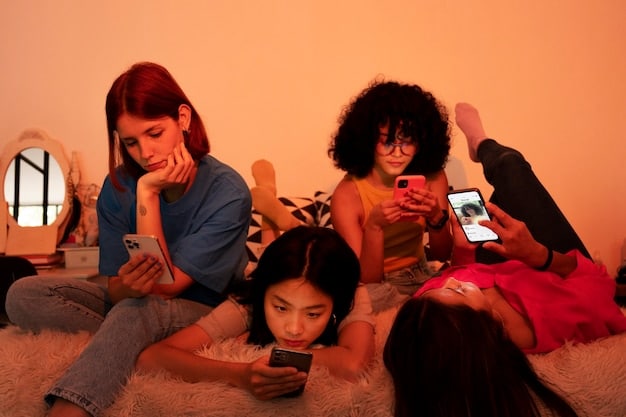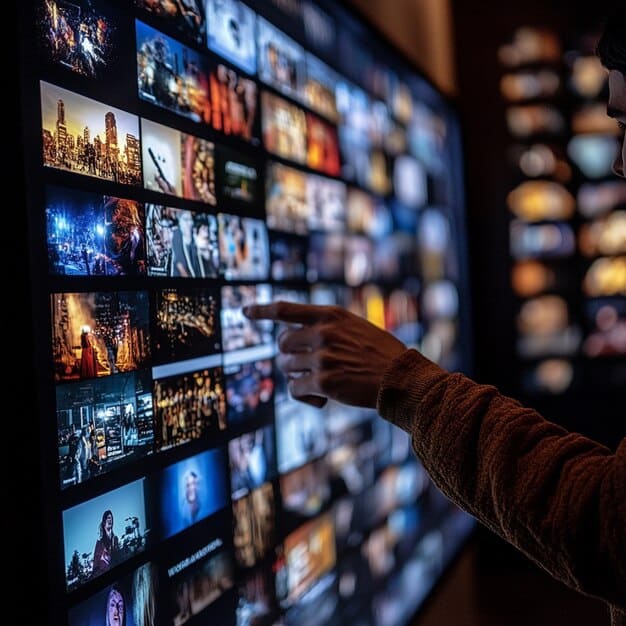Best Korean Drama English Dubs: Streaming Services & Quality in 2025

Navigating the landscape of Korean Drama English Dubs: Which Streaming Services Offer the Best Quality and Accuracy in 2025? requires a detailed look at platforms like Netflix, Viki, and Kocowa, assessing their dubbing standards, subtitle synchronization, and overall user experience.
In the expansive and ever-evolving world of entertainment, Korean Dramas, commonly known as K-dramas, have cemented their place as a global phenomenon. From heartwarming romances to gripping thrillers, these series captivate audiences worldwide. While many purists prefer the original Korean audio with subtitles, the demand for Korean Drama English Dubs: Which Streaming Services Offer the Best Quality and Accuracy in 2025? has surged, offering an accessible entry point for new fans and a convenient alternative for long-time enthusiasts. This article delves into how streaming platforms are meeting this demand, examining their approaches to dubbing quality, accuracy, and overall viewer experience in 2025.
The Evolving Landscape of K-Drama Dubbing
The journey of K-dramas from niche content to global mainstream entertainment has been remarkable. A significant part of this expansion is attributed to their accessibility, which includes not only the widespread availability on streaming platforms but also the increasing provision of English dubs. This shift caters to a diverse audience, including those who prefer not to read subtitles, have visual impairments, or simply wish to enjoy content while multitasking.
Initially, English dubs for K-dramas were a rarity, often limited to a select few titles or fan-made efforts. However, as the popularity of K-dramas soared globally, driven by platforms like Netflix and Viki, the demand for high-quality dubbed versions grew correspondingly. This evolution reflects a broader trend in the entertainment industry: the recognition that language barriers can limit audience reach, and effective localization, including dubbing, is key to global market penetration.
In 2025, the landscape of K-drama dubbing is more sophisticated than ever. Streaming services are investing heavily in professional voice actors, advanced sound engineering, and stringent quality control processes to ensure that dubbed versions maintain the emotional resonance and narrative integrity of the original series. This commitment to quality goes beyond mere translation; it involves adapting dialogue to fit lip movements, capturing cultural nuances, and ensuring voices align with character personalities, all while aiming for a seamless viewing experience that doesn’t detract from the original artistic intent.
The Shift Towards Professional Dubbing
The transition from fan-driven projects to professional studio productions marks a significant milestone in K-drama dubbing. This professionalization brings several advantages.
- Enhanced Audio Quality: Professional studios use state-of-the-art equipment and techniques, resulting in crisp, clear audio that aligns seamlessly with the on-screen action.
- Skilled Voice Acting: Experienced voice actors are able to convey a wide range of emotions and nuances, bringing characters to life in a way that resonates with English-speaking audiences.
- Improved Lip Synchronization: While perfect lip-sync is challenging across languages, professional dubbing strives for the best possible alignment, minimizing distractibility.
This commitment ensures that viewers can immerse themselves in the story without being pulled out by jarring audio or mismatched dialogue. The industry’s investment underscores the recognition of dubbing as a crucial component of global distribution стратегии, making K-dramas more inviting to a broader demographic who may find subtitle reading cumbersome.
Moreover, the emphasis on accuracy in dubbing extends beyond literal translation. It involves a nuanced understanding of cultural contexts and idiomatic expressions to ensure that the core message and humor are preserved. This attention to detail is vital for maintaining the authenticity and appeal that first drew millions to K-dramas. The continuous improvement in dubbing quality signals a promising future for global accessibility of these beloved series, allowing more viewers to enjoy them in their preferred language format.
Netflix: Paving the Way for Global K-Drama Dubs
When discussing the prominence of English dubs for K-dramas, Netflix invariably emerges as a primary player. The streaming giant has been at the forefront of globalizing K-content, investing heavily in both original productions and licensing popular series. This strategic push includes a significant commitment to dubbing, making a wide array of K-dramas accessible to non-Korean speaking audiences who prefer dubbed audio over subtitles.
Netflix’s approach to dubbing is characterized by a global production pipeline, often involving studios and voice talents from various countries, including the US, UK, and Canada, to cater to diverse English accents and preferences. Their standard for quality is generally high, as they aim to deliver a consistent and immersive experience across all their localized content. This involves not only accurate translation but also casting voice actors whose performances align with the original Korean acting, ensuring the emotional weight and character nuances are preserved.
While the library of K-dramas with English dubs on Netflix is extensive and continues to grow, it’s worth noting that not every K-drama title on the platform offers a dubbed option. Dubbing decisions are often based on anticipated global appeal, production budgets, and the licensing agreements for specific titles. However, for a rapidly expanding list of popular and acclaimed K-dramas, Netflix provides robust English dubs, often alongside multiple other language options.

Quality and Consistency
Netflix’s commitment to quality in its dubbed content is evident in several key areas. They strive for a natural flow of dialogue, ensuring that the dubbed voices match the on-screen characters’ emotions and deliver lines with appropriate pacing and tone. The sound mixing is also meticulously handled to ensure background music and sound effects are balanced with the voice-overs, preventing a jarring audio experience.
- Professional Voice Casts: Netflix employs experienced voice actors who specialize in bringing foreign language content to English-speaking audiences.
- Cultural Adaptation: Beyond literal translation, efforts are made to adapt cultural references or jokes in a way that resonates with an English-speaking audience without losing the original intent.
- High Production Value: The dubbing process undergoes rigorous quality control, from script adaptation to final audio mixing, to meet Netflix’s global standards.
However, quality can sometimes vary between titles, depending on the specific dubbing studio employed or the complexity of the original dialogue. While most Netflix dubs are praised for their clarity and professional delivery, some viewers might occasionally notice minor discrepancies or variations in voice acting preferences. Despite these occasional nuances, Netflix remains a frontrunner in providing high-quality English dubs, making it a go-to platform for many K-drama fans seeking an auditory alternative to subtitles. Their continuous investment in diverse global content ensures that the English-dubbed K-drama library will likely expand further in the coming years, solidifying its position as a cornerstone for international K-drama consumption.
Viki and Kocowa: Dedicated K-Drama Experiences
While Netflix offers a broad spectrum of global content, Viki and Kocowa stand out as streaming services primarily dedicated to Korean entertainment, including a vast collection of K-dramas. Their focus allows for a more specialized approach to content delivery, particularly concerning subtitles and, to a growing extent, English dubs. In 2025, both platforms are recognized for their extensive K-drama libraries, but their dubbing strategies and offerings present distinct characteristics.
Viki: Community-Powered Subtitles and Emerging Dubs
Viki is renowned for its unique community-driven subtitling model, where volunteer fans translate and subtitle K-dramas in numerous languages. While this system has made K-dramas accessible to millions, the emphasis has historically been on subtitles rather than dubs. However, acknowledging the increasing demand, Viki has gradually started introducing English dubs for a select number of popular titles, particularly for its Viki Pass Plus subscribers.
The quality of Viki’s emerging English dubs aims to meet professional standards, although the volume of dubbed content is not as extensive as Netflix’s. Viki often focuses on fan favorites and high-profile series for dubbing initiatives, ensuring that these specific titles offer an enhanced viewing experience for those who prefer audio localization. The platform’s strength still lies in its rapid subtitling and comprehensive library, but its venture into professional dubbing signifies a strategic response to evolving viewer preferences.
- Select Dubbed Titles: English dubs are available for some flagship K-dramas, catering to a growing segment of their audience.
- Focus on Subtitle Quality: Viki’s core strength remains its high-quality, community-curated subtitles, which are often available much faster than professional dubs.
- Growing Investment: There’s a noticeable trend of increasing investment in professional localization processes, including dubbing, for top-tier content.
Kocowa: The Latest K-Drama Content Direct from Korea
Kocowa differentiates itself by offering a robust selection of current and classic K-dramas, often available shortly after their original broadcast in Korea. Its content library is a joint venture between major Korean broadcasters (KBS, SBS, MBC), giving it access to a vast array of fresh content. Similar to Viki, Kocowa primarily focuses on providing accurate and timely English subtitles.
As of 2025, Kocowa’s English dubbing offerings are more limited compared to Netflix or even Viki. While the platform excels in delivering the latest episodes with quick and high-quality subtitles, its strategy leans more towards speed of delivery and breadth of newly released content than extensive dubbing. Viewers who prioritize watching the newest K-dramas as they air might find Kocowa indispensable for its subtitle quality and speed, but should manage expectations regarding English dubbed options.
Both Viki and Kocowa contribute significantly to the accessibility of K-dramas worldwide. Viki, with its hybrid approach of community subtitles and selective professional dubs, and Kocowa, with its focus on rapid delivery of subtitled new content, cater to different aspects of the K-drama fan base. For those specifically seeking a broad range of English-dubbed K-dramas, Netflix currently holds the edge, but Viki and Kocowa are steadily exploring and expanding their localization efforts to meet diverse viewer needs.
Understanding Dubbing Quality and Accuracy
The perceived quality and accuracy of English dubs for K-dramas are subjective, yet critical components that greatly influence a viewer’s enjoyment. It’s not simply about translating words; it’s about translating emotion, context, and cultural nuances so that the dubbed version resonates with the new audience as powerfully as the original did with its native speakers. Several factors contribute to what constitutes a “good” dub, and understanding these can help viewers appreciate the effort involved.
Beyond Literal Translation: The Art of Localization
Accuracy in dubbing goes far beyond a word-for-word translation. A literal translation can often sound unnatural or lose the original meaning, especially when dealing with idioms, cultural references, or specific Korean terms that have no direct English equivalent. This is where localization comes into play—the process of adapting content to a specific locale, ensuring it is linguistically, culturally, and stylistically appropriate.
- Cultural Nuances: Dubbing teams must consider how to best convey Korean customs, social hierarchies (e.g., honorifics), and common phrases that might not translate directly into English without losing their impact.
- Humor and Pacing: Jokes and comedic timing are often very culture-specific. Dubbers need to find equivalent expressions or reconstruct comedic lines to elicit similar reactions from an English-speaking audience.
- Voice Acting and Character Resonance: The choice of voice actors is paramount. Their ability to deliver lines with the right intonation, emotion, and vocal characteristics that match the on-screen actors is crucial for maintaining character integrity.
A well-dubbed K-drama will make viewers forget they are watching a translated work, allowing them to immerse themselves fully in the story and character development. This seamless experience is the hallmark of high-quality dubbing and requires a deep understanding of both the source and target languages and cultures.

Challenges and Compromises
Despite the best efforts, dubbing presents inherent challenges. Lip synchronization, for instance, is notoriously difficult to achieve perfectly across different languages due to varying syllable counts and mouth movements. Dubbing studios often prioritize emotional accuracy and narrative flow over exact lip-sync, which can sometimes lead to a slight disconnect for astute viewers.
Another challenge lies in striking a balance between maintaining the original Korean essence and making the content relatable to English speakers. Some unique Korean terms or concepts might be explained in the dialogue or omitted, depending on the strategy. Viewers who are deeply familiar with Korean culture might prefer subtitles for this reason, as they offer the original phrasing.
Ultimately, the “best” quality and accuracy in dubbing depend on individual viewer preferences. Some prioritize perfect synchronization, while others value natural-sounding dialogue that captures the original spirit. Streaming services like Netflix are continually refining their dubbing processes, leveraging technology and a growing pool of voice talent to bridge linguistic and cultural gaps. Their ongoing investment suggests a future where English dubs for K-dramas will become even more sophisticated and universally appealing, making the captivating world of Korean storytelling accessible to an ever-wider audience.
Future Outlook for K-Drama English Dubs in 2025
The landscape of K-drama English dubs is not static; it’s a dynamic field continuously evolving to meet consumer demand and technological advancements. As of 2025, several trends indicate a promising and expansive future for dubbed Korean content, suggesting a wider array of choices and potentially higher quality standards across various streaming platforms.
A significant driver of this expansion is the undeniable global appetite for K-dramas. With their compelling narratives, unique cultural insights, and diverse genres, these shows have transcended linguistic barriers, becoming staples for millions of viewers worldwide. As subscriber bases grow, particularly in English-speaking territories, streaming services are incentivized to invest more heavily in localization efforts, with dubbing being a key component of this strategy.
The competition among platforms—Netflix, Viki, Kocowa, and even newer entrants—also plays a crucial role. Each platform strives to attract and retain subscribers by offering exclusive content and superior user experiences, which increasingly includes high-quality dubbed options. This competitive environment fosters innovation in dubbing technology and encourages the recruitment of top-tier voice talent and localization experts.
Technological Advancements and AI in Dubbing
The year 2025 sees the increasing integration of artificial intelligence (AI) and machine learning into the dubbing process. While human input remains indispensable for artistic nuance and cultural sensitivity, AI tools are enhancing efficiency and consistency. These advancements can aid in various aspects:
- Automated Lip-Sync Adjustment: AI can analyze original speech patterns and lip movements to suggest or even automatically adjust dialogue rhythm in the dubbed version, improving synchronization.
- Voice Synthesis and Cloning: Though still nascent for high-quality dramatic content, AI voice synthesis could potentially reduce the time and cost associated with casting and recording, especially for non-critical roles or background characters.
- Enhanced Translation Tools: Improved neural machine translation (NMT) models are providing more idiomatic and contextually aware initial translations, giving human adaptors a more refined starting point.
Despite these technological strides, the emotional depth and cultural fidelity required for K-drama dubbing will likely ensure that human oversight and creative input remain paramount. AI will serve as a powerful assistant, streamlining workflows rather than replacing the artistry of voice actors and script adaptors.
Furthermore, as K-pop continues its global dominance, often hand-in-hand with K-dramas, the fan base for Korean content is only expected to grow. This sustained demand will continue to push streaming services to make K-dramas as accessible as possible, with English dubs playing an ever-larger role. The future promises a richer, more diverse selection of dubbed K-dramas, crafted with increasing precision and care, solidifying their place in the global entertainment lexicon for years to come.
Choosing the Right Service for Your Dubbed K-Drama Fix
With an increasing number of K-dramas being offered with English dubs, choosing the right streaming service can depend on a variety of factors tailored to individual viewer preferences. While Netflix, Viki, and Kocowa are the primary contenders, understanding their specific strengths and offerings will help you make an informed decision in 2025.
Criteria for Selection
When weighing your options, consider these key criteria:
- Extent of Dubbed Library: How many K-dramas with English dubs are available? Some services specialize more in this area than others.
- Quality of Dubs: Does the dubbing sound natural? Are the voices fitting for the characters? Is the synchronization acceptable?
- Speed of Dub Release: How quickly are new K-dramas or episodes dubbed after their original Korean broadcast?
- Overall Content Library: Beyond dubs, what other K-dramas or Korean content does the service offer?
- Cost and Subscription Model: What’s the price point, and does it align with the value you perceive in their dubbed offerings?
For viewers whose primary concern is the sheer volume and continuous expansion of professionally English-dubbed K-dramas, Netflix often stands out. Its global investment strategy means a significant portion of its popular K-drama catalog, especially their Originals, includes high-quality dubbing. This makes it an ideal choice for binge-watching well-known titles without reading subtitles.
If you’re a discerning viewer who also appreciates original audio with subtitles, but enjoys the option of dubs for specific, highly popular series, Viki might be an excellent choice. While their dubbed library is not as extensive as Netflix’s, the quality of their chosen dubbed titles is generally high. Viki also offers a unique community experience and incredibly fast, high-quality subtitling for a vast array of dramas, making it a comprehensive K-drama hub.
Kocowa, on the other hand, is best suited for fans who want immediate access to the latest K-drama episodes straight from Korea, often available hours after their broadcast with fast and accurate English subtitles. While their dubbed content is currently more limited, it’s the go-to for staying current with trending shows. For those who prioritize the absolute latest releases above extensive dubbing, Kocowa fulfills a unique niche.
Ultimately, the “best” service is subjective and depends on your viewing habits. Many K-drama enthusiasts find value in subscribing to multiple services to cover all their bases—enjoying the vast dubbed library on Netflix, the rapid subtitling and community features on Viki, and the latest releases on Kocowa. As the demand for K-drama English dubs continues to grow, we can expect all platforms to enhance their offerings, providing even more choices and higher quality for fans in the years to come.
Tips for Enhancing Your Dubbed K-Drama Experience
While English dubs offer a great way to enjoy K-dramas without the need for subtitles, there are several strategies viewers can adopt to make their experience even more enjoyable and immersive. These tips range from managing expectations about dubbing quality to optimizing your viewing setup, ensuring you get the most out of every episode.
Managing Expectations and Appreciating the Nuances
It’s important to approach dubbed content with realistic expectations. No dub will perfectly replicate the original performance, as language, cultural context, and vocal delivery are inherently tied to the native language. However, a good dub aims to convey the essence, emotion, and narrative intent effectively. Appreciating the effort involved in localization can enhance your viewing pleasure.
- Focus on the Narrative: Allow yourself to be drawn into the story and character development, rather than fixating on minor discrepancies in lip-sync or vocal timbre.
- Try Different Dubs (if available): For some popular titles, multiple dubbing options in English (e.g., US English vs. UK English) might be available. Experimenting can help you find a voice cast or accent style you prefer.
- Consider Speaker Identity: Remember that voice actors are portraying characters. Their voices are chosen to match the character’s age, personality, and on-screen presence, even if they don’t perfectly mimic the original actor’s vocal qualities.
Sometimes, what initially feels “off” in a dubbed performance can become a new layer of character interpretation. Give yourself time to adjust to the dubbed voices, especially if you’ve previously watched the drama with subtitles or in its original Korean audio.
Optimizing Your Viewing Setup
The technical aspects of your viewing environment can significantly impact the quality of the dubbed audio. Good sound is crucial for an immersive experience.
A high-quality audio setup can make a substantial difference. Whether you’re using a home theater system, soundbar, or even good headphones, ensuring clear sound reproduction will highlight the efforts of the dubbing team. Adjust your speaker settings to a comfortable but clear volume level, and consider enabling any available audio enhancements like dialogue clarity modes.
Ensure your internet connection is stable and fast enough to stream high-definition video and audio without buffering. Interruptions can detract from the storytelling and make the dubbed performance seem less cohesive than it is. Most streaming services automatically adjust quality based on bandwidth, but a robust connection guarantees the best possible streaming experience.
Finally, minimize distractions in your viewing environment. A quiet setting allows you to fully engage with the dubbed dialogue and the accompanying visuals, enhancing your connection to the story. By combining realistic expectations with an optimized setup, you can ensure that English dubs, particularly from platforms like Netflix, Viki, and Kocowa, provide a highly satisfying and accessible gateway into the captivating world of K-dramas.
Regional Preferences and Content Availability
The accessibility and quality of Korean Drama English dubs are not uniform across the globe; they often depend significantly on regional licensing agreements, audience demographics, and the strategic priorities of streaming services in different markets. While a K-drama might have an English dub available in the US, it might not be accessible in other English-speaking countries like the UK, Australia, or Canada, or vice versa. This regional variability is a crucial aspect for international K-drama fans to understand in 2025.
The Impact of Licensing Agreements
Streaming content, particularly international productions, is heavily governed by complex licensing agreements. These agreements dictate where, when, and in what formats (including dubs and subtitles) a particular show can be streamed. A specific K-drama might be licensed to Netflix in one region, but to Viki or a local broadcaster in another. These agreements often specify dubbing rights as well, leading to differences in availability of English-dubbed versions across territories.
- Exclusive Regional Deals: A company might acquire exclusive rights to a show for a particular country or continent, affecting its availability elsewhere.
- Dubbing Rights Included: Some licensing deals explicitly include rights for dubbing, while others do not, requiring separate negotiations.
- Audience Demand Studies: Streaming services often conduct market research to determine which regions have a higher demand for dubbed content versus subtitled content, influencing where they invest in dubbing efforts.
This fragmentation means that a K-drama enthusiast looking for a specific English dub might need to check multiple streaming services or be aware that the dubbed version might only be available in certain geographic areas. This also explains why, when a K-drama is globally popular, platforms like Netflix often acquire worldwide rights, allowing for a more consistent release of dubbed versions across all their operational regions.
Navigating Regional Content Differences
For viewers in the US, major platforms like Netflix, Viki, and Kocowa generally offer the most comprehensive access to K-dramas and their English-dubbed versions, given the significant market size and demand. However, even within a major region, the specific titles available with dubs can vary over time as licenses expire and new content is added.
To navigate these regional differences, K-drama fans often rely on:
Community forums and fan sites, where users share information about new dub releases and regional availability, can be invaluable resources. Staying updated on announcements from the streaming services themselves regarding new content rollouts and localization efforts is also key. Additionally, some viewers use VPNs (Virtual Private Networks) to access content libraries from different regions, although this practice is often against the terms of service of streaming platforms and its effectiveness can vary.
As the global reach of K-dramas continues to expand, there’s a growing push for more universal availability of dubbed content. While regional licensing will likely remain a factor, increased investment in global distribution and localization by major streaming giants suggests a future where English dubs become more consistently available across various territories, satisfying the growing international fan base for Korean storytelling.
| Key Aspect | Brief Description |
|---|---|
| 📺 Netflix Lib. | Extensive library with wide range of K-dramas, many with quality English dubs available. |
| ✨ Viki/Kocowa Focus | Specialized K-drama platforms; Viki has some dubs, Kocowa prioritizes fast subtitles. |
| 🗣️ Dub Quality | Professional voice acting and localization efforts are improving across platforms. |
| 🌍 Reg. Availability | Dubs can vary by region due to licensing agreements. |
Frequently Asked Questions About K-Drama English Dubs
▼
No, not all K-dramas on Netflix offer English dubs. While Netflix has significantly expanded its dubbed K-drama library, particularly for its popular original series and global hits, many older or less globally popular titles are often only available with original Korean audio and subtitles. Availability of dubs depends on licensing agreements and Netflix’s investment decisions for each title.
▼
The quality of English dubs can vary between streaming services and even between different titles on the same platform. Netflix generally maintains a high standard for its dubbed content due to significant investment. Viki and Kocowa are increasingly adding professional dubs to select titles, but their primary focus still leans towards high-quality, fast subtitles. Viewers might notice differences in voice acting, sound mixing, and lip synchronization.
▼
Reasons for dubbing vary: high anticipated global demand, significant budget allocation, or the series being a major international sensation. Older dramas, titles with niche appeal, or those without global distribution rights often lack dubs. Dubbing is an expensive and time-consuming process, so services strategically choose which titles to localize based on various factors, including market potential and existing licensing agreements.
▼
Professional English dubs strive for accuracy, but it’s more about localization than word-for-word translation. This means adapting cultural nuances, idioms, and humor to resonate with an English-speaking audience while preserving the original intent and emotional impact. While not always perfectly literal, a good dub aims for contextual and emotional fidelity, ensuring the story’s essence is conveyed effectively despite language differences.
▼
Yes, on most major streaming services like Netflix, you can seamlessly switch between English-dubbed audio and the original Korean audio with English subtitles. This functionality allows viewers to choose their preferred viewing experience or even switch mid-show to compare and appreciate both versions. Check the “Audio & Subtitles” options within the player settings for each specific K-drama title you are watching.
Conclusion
The journey of Korean Drama English dubs from a niche offering to a prominent feature on major streaming platforms reflects the global ascendancy of K-content. In 2025, services like Netflix lead with expansive, high-quality dubbed libraries, while dedicated platforms like Viki and Kocowa are making strategic inroads, balancing their core subtitle offerings with growing dubbing efforts. The continuous investment in professional localization processes, coupled with advancements in AI, promises an even richer and more accessible future for English-dubbed K-dramas. Whether for convenience, accessibility, or a fresh viewing experience, the options for enjoying these captivating stories in English continue to expand, solidifying K-dramas’ place in the hearts of diverse audiences worldwide.





